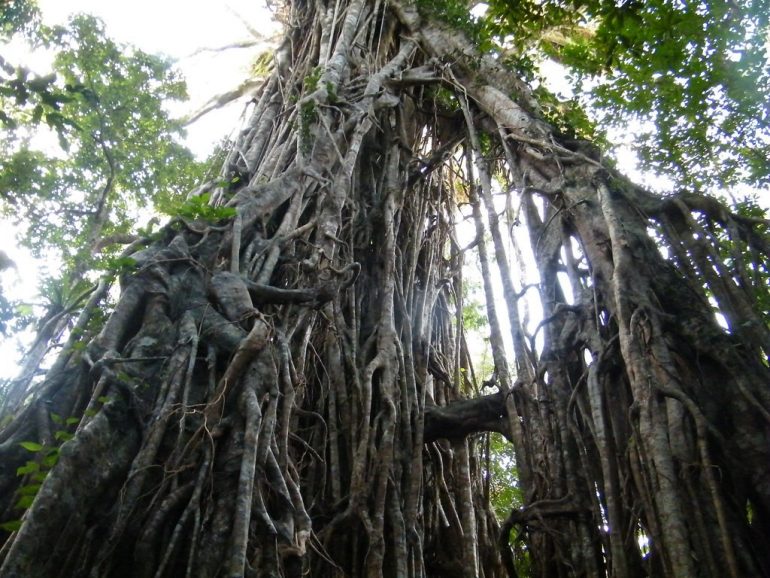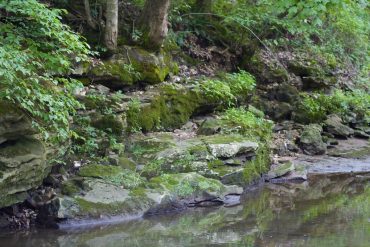Sometimes when I work with retreat groups, I start by having them engage in a simple storytelling exercise called babbling,1 in which retreatants pair up and each person speaks for a minute on a word I provide. It is a spontaneous activity, and the idea is to just notice what comes up in the moment. I might offer words like lemon, mountain, wolf, or purple, and people tell stories that arise in the moment. Then the last thing I ask participants to reflect on is a place that is a sanctuary for them. There is often a shift of energy in the room as people describe their own sanctuary places, and the majority of people describe a place in nature.
Biologist Colin Tudge writes in his book about trees, “Groves of redwoods and beeches are often compared to the naves of great cathedrals: the silence; the green, filtered, numinous light. A single banyan, each with its multitude of trunks, is like a temple or mosque—a living colonnade. But the metaphor should be the other way around. The cathedrals and mosques emulate the trees. The trees are innately holy.”2 Next time you are in the forest, imagine this space as one of the primordial or original churches—a sanctuary that has helped inspire the creation of thousands of other sanctuary spaces. Notice what arises in your body when you imagine being in the cathedral of trees, joining them in praise of the Holy. Pause and slow down, aligning yourself with God’s presence there. The cathedrals we build reflect the sacred spaces that trees have already been creating for thousands of years.
Some of the stories of St. Patrick tell us that he first learned to pray outside during his early years as a slave in Ireland and how his presence in the woods and the mountains summoned forth a continual stream of prayers in response to that sacred space. The Celtic tradition holds closely the idea of thin places, where heaven and earth touch. The landscape in Ireland where I live is dotted with hundreds of sacred spaces including holy wells, sacred mountains, and stone ruins.
St. Francis of Assisi is probably the saint that most often comes to mind when we consider how to connect to the beauty and solace of nature. His church was in the more-than-human world of nature that he loved so dearly: “Sometimes he preached by the candle-light of stars. Often the cloistering trees along the roadside made his chapel, and the blue sky was the only roof between him and heaven. Often his choir was of the brother birds in the branches and his congregation a group of brother beasts.”3
Field and forests, mountains and shorelines became the site for St. Francis’s worship and discovery of the intimacy of God. He is known for preaching to the birds and for the prayers he wrote that celebrate the gift of the natural elements.
Joachim of Fiore was a twelfth-century Cistercian mystic in Italy who likely influenced St. Francis. He is also known for worshipping outside. It is said that sometimes when he was leading a service and the clouds cleared away, “he saluted the sun, sang the Veni Creator, and led the congregation forth to view the shining landscape.”4
When we take Christ’s Incarnation seriously, we discover that the Holy is indeed everywhere. Church spaces are beautiful and sacred, invoking the Sacred Presence and providing important places to gather. But nature offers us the original cathedrals and churches. When we step among trees with our eyes and hearts open, we discover the radiance to be found there. Jesuit paleontologist Pierre Teilhard de Chardin writes, “By means of all created things, without exception, the divine assails us, penetrates us, and molds us. We imagined it as distant and inaccessible, whereas in fact we live steeped in its burning layers. . . . The world, this palpable world, which we were wont to treat with the boredom and disrespect with which we habitually regard places with no sacred association for us, is in truth a holy place, and we did not know it.”5 The world we live in is “in truth a holy place,” and our task is to remember this and to cultivate a growing awareness of the ways in which forest and hills can inspire a sense of sanctuary in our hearts. We would not desecrate our chapels and churches; in the same way, the more we nurture this intimate connection to Earth, the more we will be inspired to protect it at all costs.
Geobiographies and Archetypal Landscapes
Archetypal landscapes are spaces that are evocative and meaningful to people across cultures and time. Their existence acknowledges that we are shaped by the landscape we live in and that some landscapes speak to our hearts more clearly and resoundingly than others.
For some of us, it may be the forest that calls to us as the great cathedral of creation. For others, mountaintops are the pinnacle, offering an experience of spiritual transcendence. Or perhaps it is the sea that calls to your heart, offering her rhythm of pouring forth or drawing back, creating a temple out of its depths and hallowed ground at the rich space where sea meets earth.
Scripture is filled with holy encounters on top of mountains, in caves, and by lakes, rivers, and seas. Irish monks were inspired by the desert call to find solitude in wild places and journeyed out to the wilderness for an experience of radical intimacy with God.
One of the ways to connect more deeply and intimately with a felt sense of creation as the original sacred space is to remember the landscapes that have personal significance. Art therapist Peter London describes these as “geobiographies,” the inner contours of the landscape of our souls:
Each of the great forms that Earth takes—mountains and hills and plains and valleys and meadows and steppes and swamps and marshes and deserts and forests and jungles and savannas and beaches and islands—each of these geographies we transmute to geobiographies of our own personal journey across time and circumstance. We too rise up, we ascend, we fall, only to rise and fall over and over, until we are leveled and become one again with the single mantle that is the resting ground and birthing ground of it all. The meanings we ascribe to the trajectory of our lives are the same ones we observe in the fate of the Earth. The finite summit of the mountain’s peak, the river’s final arrival to the sea, the clearing in the depths of the woods, serve as exemplars and as metaphors for the often steep and uncertain and perilous journey that is our life.6
Earth has multiple terrains, as does the soul. Becoming familiar with the outer landscape reveals dimensions to us of our inner ones as well. Recognizing which territories enliven our souls and which ones challenge us brings us closer to discovering who we most deeply are and what we long for.
Mary Reynolds Thompson, in her book Reclaiming the Wild Soul: How Earth’s Landscapes Restore Us to Wholeness, describes five archetypal landscapes she calls “soulscapes,” which are the meeting point between the inner world of self and the outer world of Earth. These soulscapes are desert, forest, oceans and rivers, mountains, and grasslands.7 Each landscape has a set of unique gifts and invitations, including the draw from simplicity to mystery, the flow of our desires, the power we have to inspire and shape the world, and the call to settle into a place and create community.
When John, my husband, and I were finishing up graduate school in the San Francisco Bay area, we visited a friend in Seattle, Washington, and we both fell in love with the Pacific Northwest. The landscape, with its intertwining of forest, sea, lake, and mountain, kindled something in our hearts we hadn’t felt before—the land was calling to both of us. Over the nine years we lived there, I especially fell in love with the places where the wild edges meet—the borderland between forest and sea—and I discovered this place within me. We each have within us many threshold places where our love of the Divine meets our love of the world, where our hearts and minds unite, where the differing parts of ourselves come together to listen to our calling in the world.
When we moved to Vienna, Austria, from Seattle because of a call to adventure, the Wienerwald (Vienna woods) became a source of great solace for me as I dealt with the loneliness of living in a new place far away from my familiar life, and I deepened in my appreciation of the witness of trees. Now living on the west coast of Ireland, I am learning to love the rawness of this wild edge, the way the wind blows fiercely off the Atlantic, the haunting sound creating its own kind of church bell summoning my attention back to the current moment in time. In this place with few trees, stone has become vitally important for my sense of what it is that endures.
Think of the garden path or diving into the deep sea, of climbing majestic mountains or crossing wide open plains. Even walking through an urban neighborhood has its own kind of resonance. Each one has a particular quality that evokes something within us.
Pause for a moment and imagine each of these places, and allow a few moments simply to become aware of your body’s physical response to a particular kind of landscape. Some may make your heart soar, while others make it contract; some may create no real felt response at all. Recognizing Earth as our original cathedral means deepening our love for the ground that nourishes us. It means finding the spots nearby where we can sit and ponder and be with nature in all her splendor.
Bibliography
1. See Interplay.org for more information on this exercise.
2. Colin Tudge, The Tree: A Natural History of What Trees Are, How They Live, and Why They Matter (New York: Three Rivers Press, 2005), xvii.
3. Abbie Farwell Brown, The Book of Saints and Friendly Beasts (New York: Houghton, Mifflin & Co., 1900), 83.
4. Edward Allworthy Armstrong, Saint Francis: Nature Mystic: The Derivation and Significance of the Nature Stories in the Franciscan Legend (Berkeley: University of California Press, 1973), 30.
5. Pierre Teilhard de Chardin, Divine Milieu (New York: Harper & Row, 1960), 83.
6. Peter London, Drawing Closer to Nature: Making Art in Dialogue with the Natural World (Boston: Shambhala, 2003), 202.
7. Mary Reynolds Thompson, Reclaiming the Wild Soul: How Earth’s Landscapes Restore Us to Wholeness (Ashland, OR: White Cloud Press, 2014), xix.
This excerpt from Earth, Our Original Monastery: Cultivating Wonder and Gratitude through Intimacy with Nature is reprinted with permission of the publisher, Ave Maria Press.





